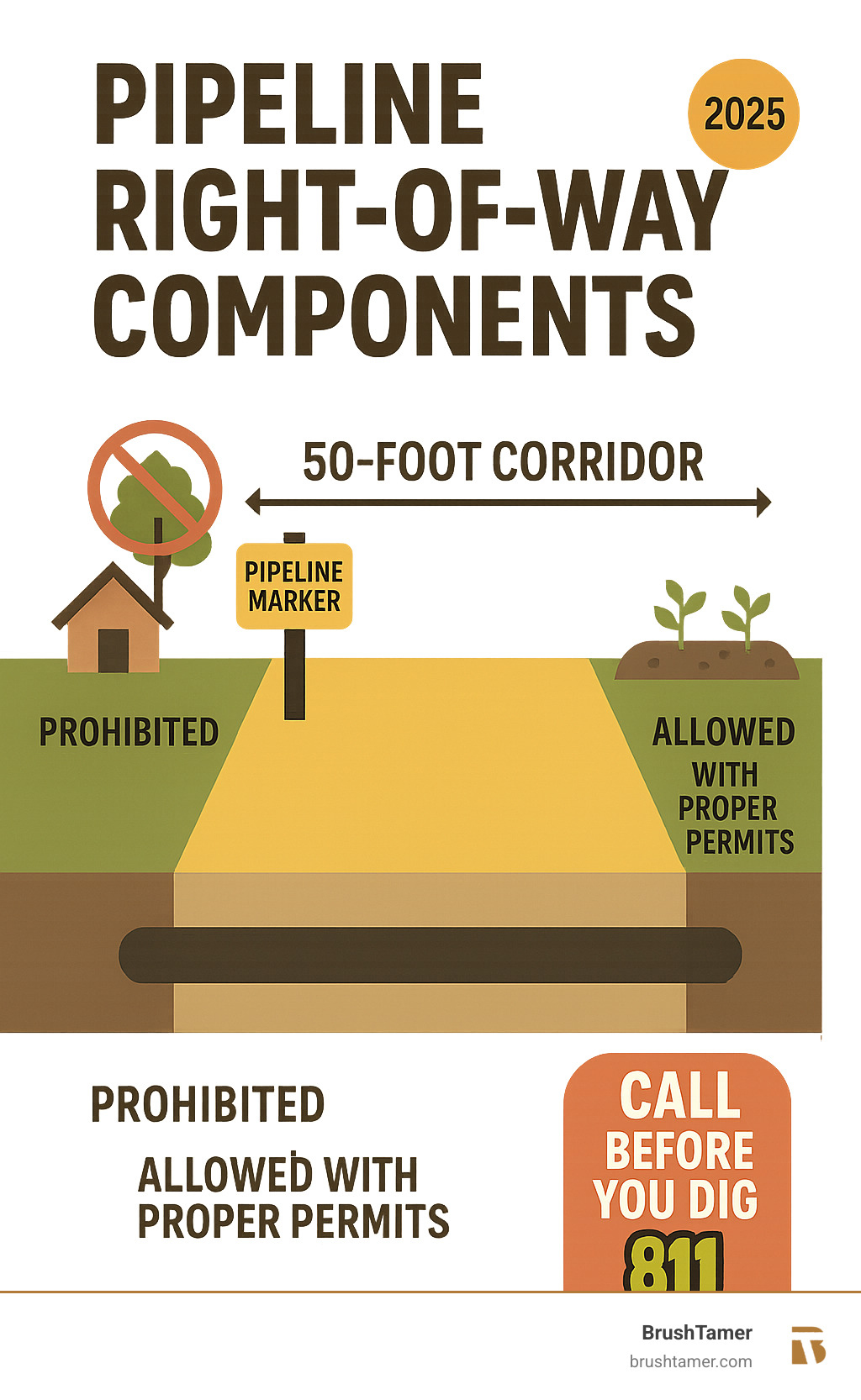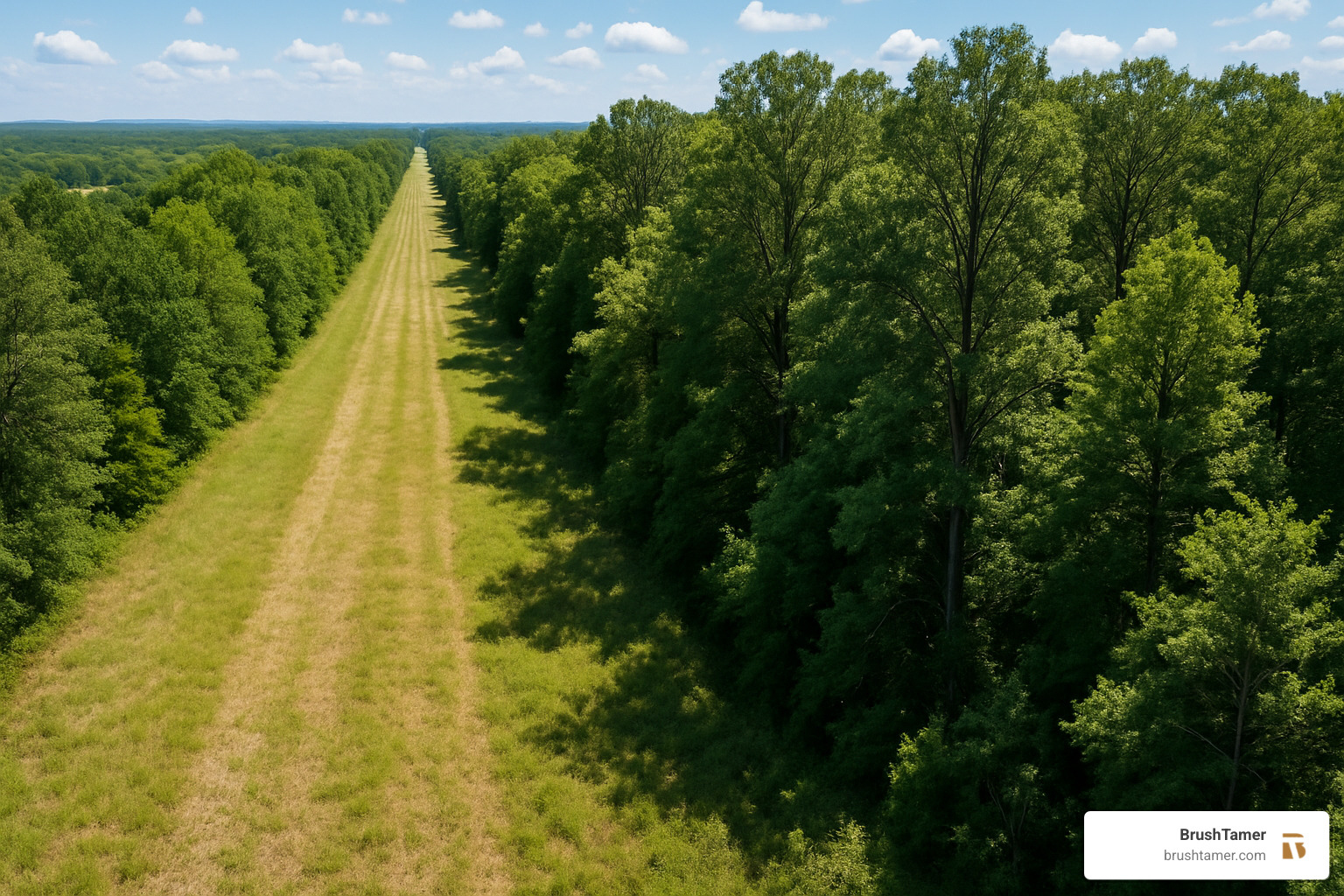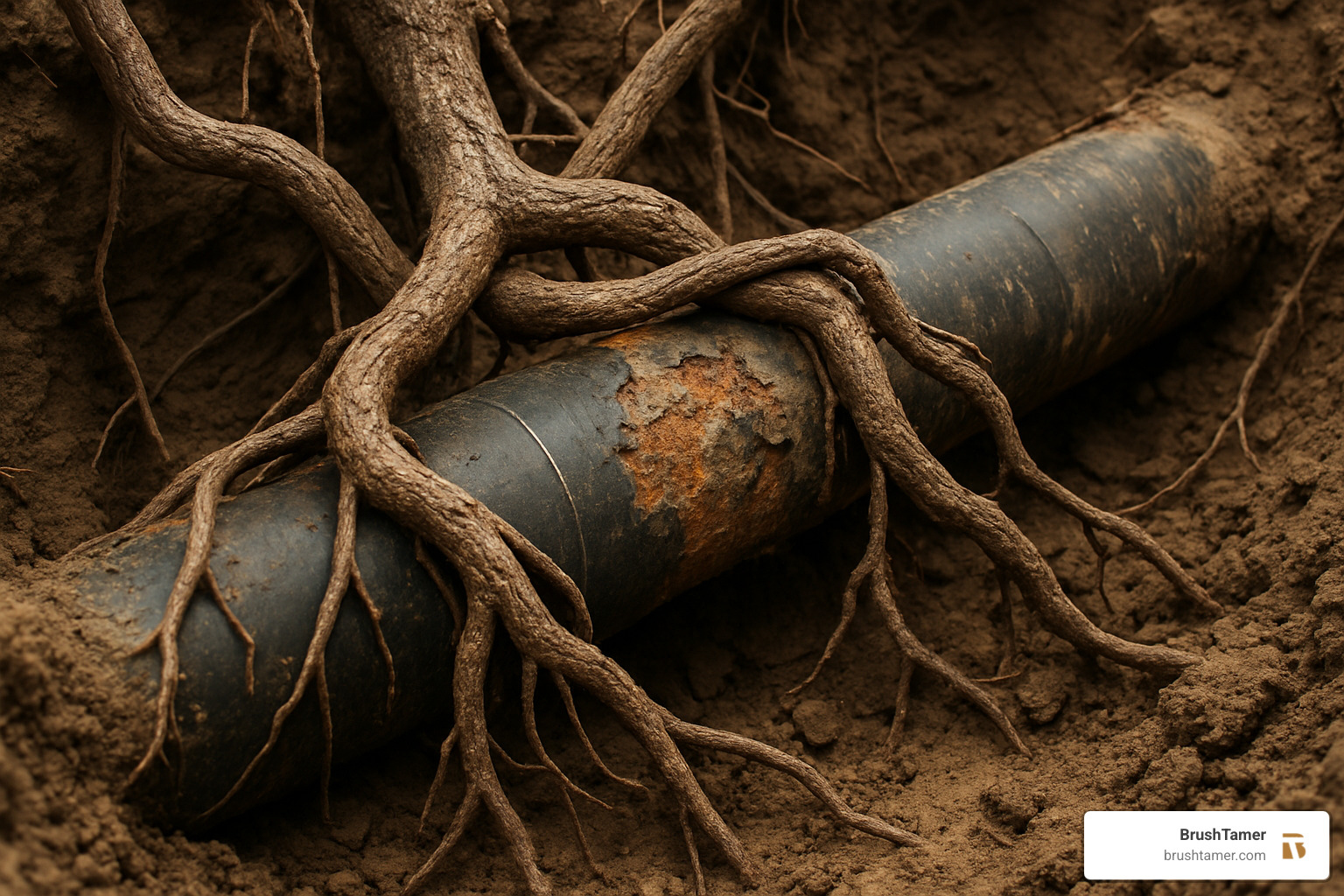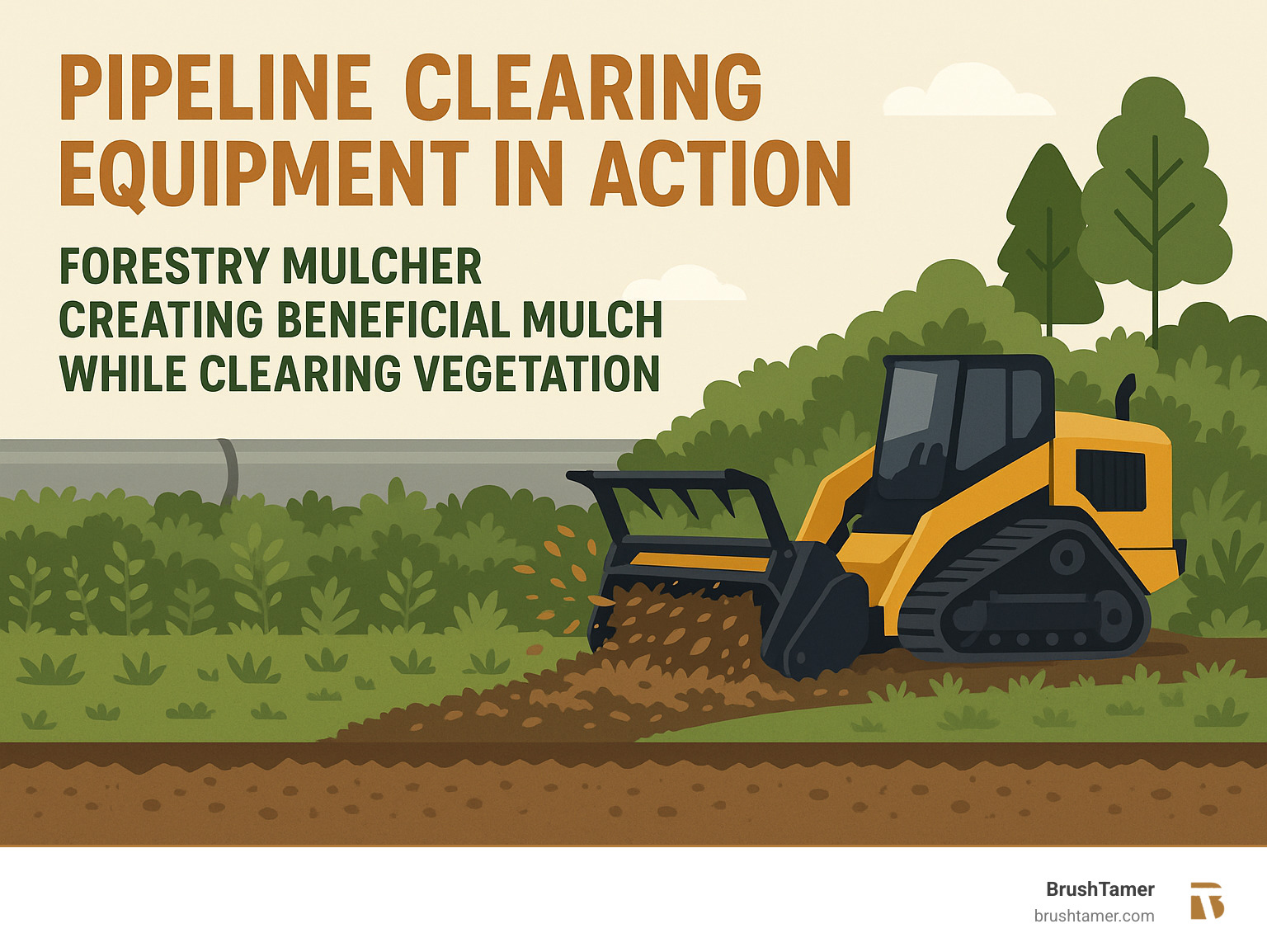Why Pipeline Right of Way Clearing is Essential for Safe Operations
Pipeline right of way clearing is the systematic removal of vegetation, debris, and obstructions from designated corridors that contain oil, gas, or other utility pipelines. This process ensures safe operations, regulatory compliance, and long-term infrastructure integrity.
Key reasons pipeline ROW clearing matters:
- Safety: Prevents third-party damage and enables emergency access
- Inspection: Allows aerial and ground patrols to monitor pipeline integrity
- Compliance: Meets federal DOT requirements for routine maintenance
- Asset Protection: Prevents root damage to protective pipeline coatings
- Public Awareness: Maintains visibility of pipeline markers and safety zones
Pipeline rights-of-way are typically 50 feet wide (25 feet on each side of the pipe) and serve as legally established safety corridors. These areas must remain clear of trees, buildings, and other obstructions to enable construction, maintenance, inspection, and emergency response activities.
The stakes are high – third-party “hits” are the number one cause of pipeline damage in the United States, and a survey reveals that 34.9 million Americans put themselves at risk by digging on their property without proper utility location services.
As Leon Miller, owner of BrushTamer, I’ve worked extensively with pipeline operators and landowners to provide safe, efficient pipeline right of way clearing services throughout challenging Indiana terrain. My hands-on experience has shown me how proper vegetation management protects both critical infrastructure and the communities these pipelines serve.

Understanding the Pipeline Right-of-Way (ROW)
Think of a pipeline right-of-way as a permanent highway for energy infrastructure. It’s a legally established strip of land that gives pipeline companies specific rights to build, maintain, and operate their pipelines – even when that land belongs to someone else.
A right of way is a legal right that’s created through easement agreements between pipeline operators and property owners. These aren’t temporary arrangements – they’re recorded legal documents filed at your county courthouse that create lasting rights and responsibilities.
Here’s what makes easements unique: they “run with the land.” This means if you buy property with an existing pipeline easement, you inherit both the compensation and the restrictions that come with it. The easement becomes part of your property’s legal description forever.
Pipeline right-of-way widths vary dramatically depending on what’s flowing through them and at what pressure. Distribution pipelines serving local communities might only need a 10-25 foot corridor, while transmission pipelines carrying high-pressure gas across states can require corridors up to 150 feet wide.
In my experience working across Indiana, Illinois, Michigan, Wisconsin, and Ohio, we most commonly encounter transmission pipelines with 50-foot corridors – that’s 25 feet on each side of the actual pipe. These wider buffer zones aren’t arbitrary; they’re carefully calculated safety margins that protect both the pipeline and surrounding communities.
The scope of pipeline infrastructure is staggering. As of 2020, over 1.18 million kilometers of oil and gas pipelines span 162 countries worldwide. Right here in the Midwest, we’re crisscrossed by thousands of miles of these critical energy arteries, each requiring regular pipeline right of way clearing to operate safely.
Why a Clear ROW is Non-Negotiable

Pipeline companies don’t clear their rights-of-way because they like the look of mowed grass – they do it because federal law requires it. The U.S. Department of Transportation mandates regular pipeline inspections, and you simply can’t inspect what you can’t see.
Aerial patrols are the backbone of pipeline safety monitoring. Pilots fly predetermined routes looking for signs of leaks, unauthorized activity, or potential threats. But when trees and brush block their view, these crucial safety checks become impossible. That forces companies to rely on slower, more expensive foot patrols – and in the pipeline world, delayed detection can mean disaster.
Emergency response access is another non-negotiable requirement. When something goes wrong with a pipeline, every second counts. Emergency crews need to reach the problem area immediately with specialized equipment. Trees, large shrubs, and other obstructions can turn a manageable incident into a catastrophic event.
There’s also the issue of preventing third-party damage. A clear right-of-way serves as a visual reminder that critical infrastructure lies beneath the surface. Pipeline markers are only effective if people can actually see them through the vegetation.
Finally, regulatory compliance isn’t optional. Pipeline companies face substantial fines when their rights-of-way don’t meet federal inspection standards. Overgrown easements can trigger violations during regulatory audits, creating expensive problems that proper vegetation management prevents.
What Landowners Need to Know About Easements
When a pipeline company needs to cross your property, they’ll approach you with a Grant of Easement – a legal contract that spells out exactly what rights they’re purchasing and what compensation you’ll receive. These agreements are typically permanent easements that become part of your property’s legal description.
Understanding what’s prohibited within pipeline easements can save you headaches down the road. You generally can’t build structures like houses, garages, or sheds over the pipeline. Planting trees or large shrubs is also typically forbidden, as is storing materials or equipment in the easement area. Swimming pools, decks, and mobile homes are usually off-limits too.
But don’t worry – you can still use your land in many ways. Utilities can cross the easement with proper coordination, and driveways and roads are often permitted. Fences are usually allowed, and approved parking areas might be possible depending on your specific agreement.
If you’re buying property or want to understand existing easements on your land, start with your county recorder’s office. These easement documents are public records, and understanding your rights and responsibilities is crucial for avoiding conflicts. More about property owner rights can help you steer the legal complexities of pipeline easements.
The key is communication. Pipeline companies want to maintain good relationships with landowners, and most issues can be resolved through honest conversation about what’s needed for safe operations.
The Critical Objectives of Pipeline Right of Way Clearing
Every time we tackle a pipeline right of way clearing project, we’re working toward goals that go far beyond just cutting down trees and brush. After years of working with pipeline operators across Indiana and the surrounding Midwest, I’ve seen how proper vegetation management creates a foundation for safe, efficient energy infrastructure.
The reality is sobering: statistics show that 34.9 million Americans put themselves at risk by digging without proper utility location services. This makes our work more than just maintenance – it’s about protecting communities and preserving critical infrastructure that keeps our energy systems running.
Pipeline integrity, safety protocols, operational efficiency, and environmental stewardship all depend on maintaining clear rights-of-way. These aren’t separate goals – they work together to create a comprehensive approach to pipeline protection. When we do this work right, we’re reducing risk while enabling the proactive maintenance that prevents small problems from becoming major emergencies.
Enhancing Safety and Preventing Accidents
Third-party hits are the number one cause of pipeline damage in the United States, and most of these accidents are completely preventable. When we maintain clear corridors, we’re creating multiple layers of protection that help prevent these dangerous incidents.
Think about it this way: if you can’t see the pipeline markers, you don’t know there’s a pipeline there. Overgrown vegetation that obscures these critical safety markers puts everyone at risk. These markers contain essential information – what the pipeline carries, who operates it, and emergency contact numbers. When brush and trees hide them, property owners and contractors may unknowingly work near dangerous infrastructure.
Public awareness starts with visibility. Clear rights-of-way serve as visual reminders that pipelines are present. This visibility is crucial for the Call 811 before you dig system to work effectively. People need to know pipelines exist before they can take proper precautions.
Emergency response access is another critical safety factor. In the event of a pipeline release or emergency, crews need immediate, unrestricted access to the affected area. Trees and large shrubs can prevent emergency personnel from reaching the pipeline quickly, potentially turning a manageable situation into a catastrophe.
Fire hazard reduction is especially important around above-ground facilities and valve stations. Overgrown vegetation in these areas creates significant fire risks and can prevent emergency crews from accessing critical infrastructure when they need it most.
Protecting Pipeline Integrity from Natural Threats

Here’s something that surprises many people: tree roots are naturally drawn to pipelines. The moisture and warmth that pipelines provide create an attractive environment for root growth. Over time, these roots can wrap around pipelines and damage the protective coating that prevents corrosion.
That protective coating is the pipeline’s primary defense against long-term degradation. When tree roots compromise this coating, it can lead to costly repairs, service interruptions, and potentially dangerous situations. I’ve seen cases where abnormal root formations have developed near underground pipelines, creating serious integrity concerns that could have been prevented with proper vegetation management.
Soil stability is another factor we carefully consider during our clearing operations. Proper vegetation management helps maintain appropriate drainage patterns and prevents erosion that could expose or destabilize pipeline infrastructure. We use techniques like mulching that leave beneficial ground cover while removing problematic vegetation, maintaining the soil stability that pipelines need for long-term asset protection.
Water drainage management is particularly important here in the Midwest, where seasonal flooding and wet conditions are common. Clear rights-of-way allow for proper water flow and prevent the accumulation of debris that could cause flooding or erosion around pipeline infrastructure. This helps prevent obstructions that could interfere with pipeline operations or create safety hazards.
Ensuring Operational Efficiency and Compliance
Pipeline operators face strict regulatory requirements for inspection and maintenance activities. The Department of Transportation requires routine patrolling of pipeline rights-of-way, and FERC vegetation management guidelines emphasize the importance of maintaining clear corridors for both safety and operational efficiency.
When rights-of-way are properly maintained, inspection crews can complete their work more quickly and thoroughly. This reduces operational costs and improves system reliability. I’ve worked on projects where overgrown vegetation forced inspection teams to spend days clearing access routes before they could even begin their actual inspection work. Proactive vegetation management eliminates these delays and keeps critical infrastructure operating smoothly.
Streamlined inspections are only possible when crews have unrestricted access to pipeline corridors. Maintenance crew access becomes much more efficient when rights-of-way are clear, reducing operational delays and enabling faster response times when issues arise.
Compliance with federal regulations isn’t just about avoiding fines – though those can be substantial. It’s about maintaining the operational readiness that our energy infrastructure requires. Pipeline companies that maintain clear rights-of-way can respond more quickly to maintenance needs, conduct more thorough inspections, and provide more reliable service to their customers.
This comprehensive approach to pipeline right of way clearing creates a foundation for safe, efficient energy infrastructure that serves our communities reliably for decades to come.
Modern Clearing Techniques and Equipment
The world of pipeline right of way clearing has come a long way from the days of chainsaws and burn piles. Today’s methods are smarter, more efficient, and far better for the environment. At BrushTamer, we’ve acceptd these modern techniques because they deliver better results for our clients while protecting the ecosystems we work in.
Mechanical clearing has revolutionized how we approach vegetation management. Our forestry mulchers and brush cutters can process entire trees and shrubs in place, turning what used to be waste into valuable mulch. This mulch stays on-site, preventing soil erosion and gradually enriching the soil as it decomposes. It’s a win-win situation – no hauling debris to landfills, no bare soil left vulnerable to erosion, and the land actually improves over time.
But mechanical equipment isn’t always the right answer. When we’re working near active “hot” pipelines or in areas with sensitive wildlife habitats, manual clearing becomes essential. Our experienced crews use hand felling and selective removal techniques to carefully remove only the vegetation that needs to go. This precision work requires skill and patience, but it’s the safest approach when working around critical infrastructure.
The most sophisticated approach we use is Integrated Vegetation Management (IVM). Instead of just cutting everything down and hoping for the best, IVM focuses on encouraging the right kinds of plants to grow. We promote stable, low-growing plant communities that naturally resist invasion by tall trees. This means fewer future clearing operations and a more sustainable approach to vegetation management.

Our toolkit includes several specialized methods, each chosen for specific situations. Forestry mulching converts trees and brush into beneficial mulch right on-site. Selective hand cutting allows for precise removal near sensitive infrastructure. Brush cutting and chipping processes vegetation for easy disposal or beneficial reuse. When necessary, we use targeted herbicide application to prevent regrowth of problematic species, and grubbing and grinding for complete removal of stumps and root systems.
What sets our approach apart is that we don’t just clear and walk away. We provide comprehensive Our Services that include ongoing maintenance programs designed to keep pipeline corridors in optimal condition year-round. This proactive approach saves money in the long run and ensures that safety and compliance standards are consistently met.
The key to successful pipeline right of way clearing is matching the right technique to the specific conditions we encounter. Every project is different, and our experience working throughout the Midwest has taught us to adapt our methods to terrain, weather, environmental concerns, and operational requirements.
Navigating Challenges and Environmental Responsibility
Working in pipeline right of way clearing across the Midwest has taught me that no two projects are exactly alike. After years of tackling everything from Indiana’s wetlands to Wisconsin’s rocky terrain, I’ve learned that the key to success lies in adapting our approach to each unique environment we encounter.
The landscapes we work in tell quite a story. One day we might be navigating the steep, tree-covered hillsides of western Illinois, and the next we’re carefully maneuvering through sensitive wetlands where every step matters. Each environment demands its own strategy, equipment, and level of environmental awareness.
Wetlands and marshes present some of our most complex challenges. These areas are ecologically precious, but they also need to be accessible for critical pipeline maintenance. We’ve become experts at using timber mats to create temporary roads that allow our equipment to reach the work site without damaging the delicate ecosystem beneath. These mats distribute the weight of our machinery, preventing the soil compaction that could harm wetland functions for years to come.
When we encounter ecologically sensitive areas, our approach shifts to precision over speed. We work closely with environmental consultants to identify protected species and habitats, then develop clearing plans that remove only the vegetation that poses actual risks to pipeline integrity. It’s like performing surgery with a forestry mulcher – every cut matters.
Creative vegetation management strategies have evolved tremendously over the years, and we’ve acceptd techniques that balance operational needs with environmental stewardship. Sometimes the most effective approach isn’t the most obvious one.
Soil erosion control is something we think about from day one of every project. We’ve seen what happens when this gets overlooked, and it’s not pretty. Our approach includes maintaining ground cover wherever possible, installing erosion control barriers on slopes, and seeding disturbed areas with appropriate vegetation. We also use the mulch created by our clearing operations to protect exposed soil and manage water flow to prevent sedimentation.
Tackling Difficult and Remote Terrains
Some of the most rewarding projects we’ve worked on have been in places that seemed impossible to reach. Remote pipeline corridors often require us to get creative with logistics and equipment selection. I’ve learned that with the right planning and a bit of ingenuity, there’s almost always a way to get the job done safely.
Steep slopes demand our full attention and specialized equipment. We use track-mounted machinery that can operate safely on inclines that would challenge most contractors. Sometimes we’ll position an excavator with extended reach capabilities on stable ground and clear vegetation from a distance, reducing both safety risks and soil disturbance.
Working near “hot” pipelines – those that remain in active service during our clearing operations – requires the highest level of safety protocol and crew training. My team has extensive experience working adjacent to and even on top of existing pipeline infrastructure. We follow strict safety guidelines because there’s simply no room for error when you’re working around pressurized systems carrying oil or gas.
Project logistics for remote clearing operations often feel like solving a complex puzzle. We start with detailed site surveys to plan equipment access routes, then coordinate with multiple stakeholders and regulatory agencies. Weather and seasonal access restrictions add another layer of complexity. Sometimes we’re building temporary bridges over waterways or using hand crews to access areas too sensitive for machinery.
The challenging conditions we regularly encounter have made us better problem-solvers and more adaptable contractors. Whether we’re dealing with difficult terrain, remote locations, or habitat protection requirements, we’ve learned to find solutions that work for everyone involved – the pipeline operator, the environment, and the communities we serve.
Conclusion
When you think about the energy that powers our daily lives, pipeline right of way clearing probably isn’t the first thing that comes to mind. But this essential work quietly protects the infrastructure that keeps our lights on, our homes heated, and our economy running smoothly.
After years of working across Indiana, Illinois, Michigan, Wisconsin, and Ohio, I’ve learned that proper vegetation management is about much more than just cutting down trees. It’s about safety – protecting the 34.9 million Americans who might unknowingly put themselves at risk by digging without proper precautions. It’s about integrity – preventing tree roots from damaging protective coatings that keep pipelines functioning safely for decades. And it’s about efficiency – ensuring that inspection crews can do their jobs quickly and thoroughly.
The environmental responsibility aspect of this work has become increasingly important to both our clients and our team. We’ve moved far beyond the old “clear-cut everything” approach to accept techniques that actually benefit the ecosystem while maintaining safety standards. When we mulch vegetation instead of hauling it away, we’re enriching the soil and preventing erosion. When we selectively clear sensitive areas, we’re preserving valuable habitats while still meeting operational requirements.
The challenges we face – from steep terrain to wetlands to working near active pipelines – have taught us that there’s no such thing as a routine clearing project. Each site demands careful planning, specialized equipment, and crews who understand both the technical requirements and the bigger picture of what we’re protecting.
As our energy infrastructure continues to evolve, the need for experienced professionals who can steer these complexities will only grow. Pipeline operators need partners they can trust to maintain their rights-of-way safely and efficiently. Landowners need experts who understand both the legal requirements and the environmental implications of easement management.
That’s where BrushTamer comes in. We’ve built our reputation on delivering reliable, high-quality results while treating every property – and every client – with the respect they deserve. We know that behind every clearing project are real people whose lives and livelihoods depend on us getting it right.
The stakes really are that high. When we maintain clear pipeline corridors, we’re not just following regulations – we’re protecting communities, preserving critical infrastructure, and ensuring that our energy systems can continue serving us safely for generations to come.
Partner with us for your land clearing needs and find what it means to work with a team that understands both the technical demands and the human side of pipeline right of way clearing. Because when it comes to protecting our vital energy infrastructure, experience and expertise make all the difference.
